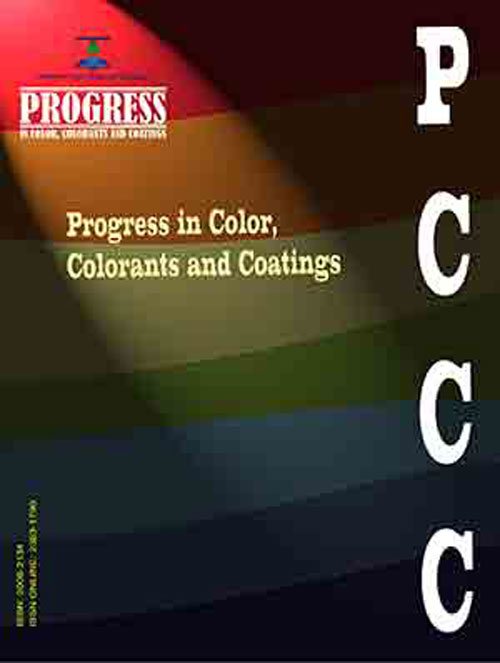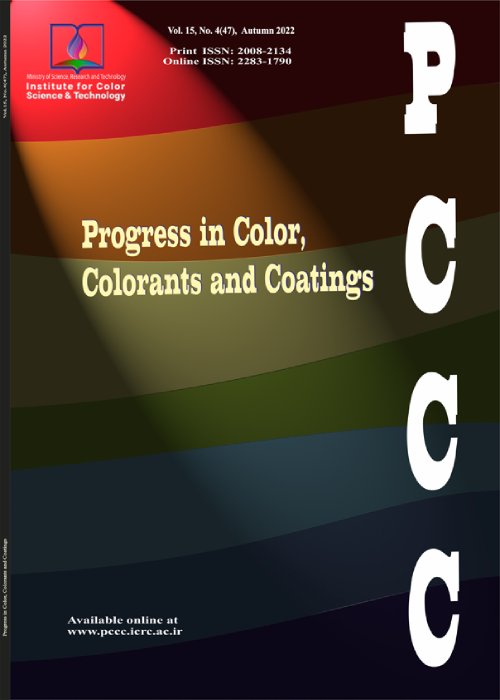فهرست مطالب

Progress in Color, Colorants and Coatings
Volume:8 Issue: 3, Summer 2015
- تاریخ انتشار: 1394/05/11
- تعداد عناوین: 7
-
-
Pages 169-176The thermo-optical properties of coated surface are important for spacecraft thermal control coatings which depend on the optical properties and structure of the coating material. These coatings control the temperature by their capability of outer energy absorption and its emission. The optical properties of pigment can be improved if the pigment contains a high fraction of voids in its structure. In this paper, mesoporous Co3O4 powders were successfully synthesized through hard template method using SBA-15. The resulting black pigment was characterized using BET, XRD and FE-SEM. The reflective property of Co3O4 was investigated by diffuse reflectance ultraviolet-visible near-infrared spectrophotometer. Reflectance measurement revealed that these mesoprous materials had high absorption property αs0.95. The resulting mesoporous Co3O4 was mixed with potassium silicate as transparent binder to make coating on Al substrate that shows high solar absorptance αs0.94 and high thermal emittance εt0.96. This study indicated that Co3O4 coating may be a promising kind of black thermal control coatings.Keywords: Mesoporous Co3O4, Thermal control coating, Absorptance, Diffuse reflection, SBA, 15
-
Pages 177-196The corrosion inhibition efficiency of benzimidazole, 2-methylbenzimidazole and 2- aminobenzimidazole for mild steel immersed in 3.5 NaCl solution was investigated by electrochemical impedance spectroscopy EIS at concentration range from 10-5 to 10-2 M of imidazoles and temperature range from 30 to 50°C. In addition, DC polarization was examined to determine inhibition mechanism at concentration range from 10-5 to 10-2 M of the imidazole derivatives. Double layer capacitance and charge transfer resistance were extracted from EIS plots after fitting with an appropriate circuit. Surface coverage was calculated based on capacitance and resistance of the corroding cell. It was found that increase of inhibitor concentration and temperature results in increase and decrease of surface coverage respectively. The results showed that these compounds have limited corrosion inhibition. The adsorption of these compounds on the steel surface obeys Temkin isotherm.Keywords: Adsorption, Corrosion, Polarization, EIS
-
Pages 197-206Four novel azo disperse dyes based on 1-4-bromobenzyl-4-phenylpiperazine were synthesized in two steps, using alkylation and azo coupling reactions. Chemical structure of the dyes was characterized and confirmed by the Ultraviolet Visible UV-Visible, Fourrier Transform Infrared FT-IR, Proton Nuclear Magnetic Resonance 1H NMR and Carbon Nuclear Magnetic Resonance 13C NMR analyses. The solvatochromic behavior of the dyes was studied in a set of 10 solvents with different polarity and considerable results were obtained. The prepared dyes were applied as disperse dyes for dyeing polyester fibers and their dyeing properties were evaluated. The fastness properties of the dyed fabrics such as wash, light and rubbing fastness degrees were measured by standard methods. Investigation of antioxidant activity of compounds was carried out by ferric reducing antioxidant power FRAP method. The activity data show that the synthesized dyes B1-B4 have promising antioxidant activity, comparable with their precursor B.Keywords: Azo disperse dye, N, phenylpiperazine, Dying, Spectroscopy, Antioxidant activity
-
Pages 207-217During recent decades due to the increase in pollutants release from various industries, reduction or elimination of volatile organic compounds VOCs has become one of the main purposes of researches in order to protect the environment. In this research, two acrylic emulsion resins and an adhesion promoter polyester emulsion resin were used to optimize water-based printing ink formulation for printing on polyolefins. Then resistance properties of printed films were evaluated. The used polyolefins were transparent polypropylene PP, transparent and opaque polyethylene PE. Adhesion of samples increased from PP to PE while it was better for opaque PE compared with transparent ones. However, scratch resistance and optical properties of samples were independent of substrate. SEM images showed that the samples with Zinpol 350 had larger structure which caused the gloss decrease while for samples containing Glascol LS26 high level morphology and small microstructure lead to higher gloss and adhesion properties.Keywords: Polyolefin, Water, Based ink, Acrylic emulsion, Print quality, Adhesion, Morphology
-
Pages 219-235This study reports an application of instrumental color measurement for quantifying and comparing the optical properties of high density polyethylene HDPE and low density polyethylene LDPE blend films and the effect of blending ratio and miscibility on these properties. The technique of spectrophotometry in transmission and reflectance modes can be used as a versatile tool to evaluate the colorimetric parameters of polymers. The optical properties of the films indicated likeliness of affecting color spectrum by incorporating low-density PE LDPE into high-density PE HDPE. This is the principal reason for changing colorimetric parameters of the films. CIE colorimetric values in CIELab and CIELCho color scales and associated parameter Color Intensity CI showed that they are practical for comparing the blend films. The most change in the values versus composition was pertained to films of HDPE-rich blends which were verified miscible using thermal analysis. In this paper it was observed that the used measurement technique, through quantitative parameters provided by it, would be useful to reveal the difference in behavior of the HDPE/LDPE blends at miscible compositions from immiscible ones.Keywords: optical properties, polyethylene blend, CIELAB color coordinates, spectrophotometry
-
Pages 237-245The interactions two synthetic triazinyl reactive dyes Mono-s-chloro Triazinyl reactive dyes DI and DII with the cationic surfactant N-hexadecyl pyridinium chloride CPC were studied using a conductometric method in 25, 30, 35, 40 and 45ºC. The equilibrium constants and other thermodynamic parameters for the ion pair formation were calculated on the basis of a theoretical model using the data obtained by conductometry. The results showed that the equilibrium constants and the negative standard free energy change values for all systems decreased as temperature increased. According to thermodynamics data, formation ion pair between the dye and the surfactant was revealed to be an enthalpy-driven process which is highly dependent on the temperature and the structures of dye for both systems. These results indicate DI dye molecular structure has hydrophobic centers that make it suitable for both electrostatic and hydrophobic interactions with CPC cationic surfactant when this interaction for the DII dye with CPC can be explained only the long range electrostatic forces and short-range hydrophobic forces do not cause the formation of dye-surfactant complex.Keywords: Cationic surfactant, reactive dye, Ion pair, Equilibrium constant, Conductometry
-
Pages 247-257We synthesized four novel benzoxazolic and benzimidazolic derivatives of 6-hydroxycoumarin and their photophysical properties were studied. The products with brilliant yellow color shades declared green fluorescence. The emission peaks of the products appeared 456–474 nm. The important characteristic for fluorescent compounds, the Stokes shift νA-νF, oscillator strength f, and fluorescence quantum yield ΦF were measured. Furthermore, their photophysical and electronic properties have been investigated at the theoretical level using density functional theory. Dyeing of nylon fabrics was carried out by the synthesized fluorescent dyes as well. They generally flatten off at dye concentrations of 2-3 owf.Keywords: Benzoxazole, Benzimidazole, Coumarin dye, DFT, Fluorescence


